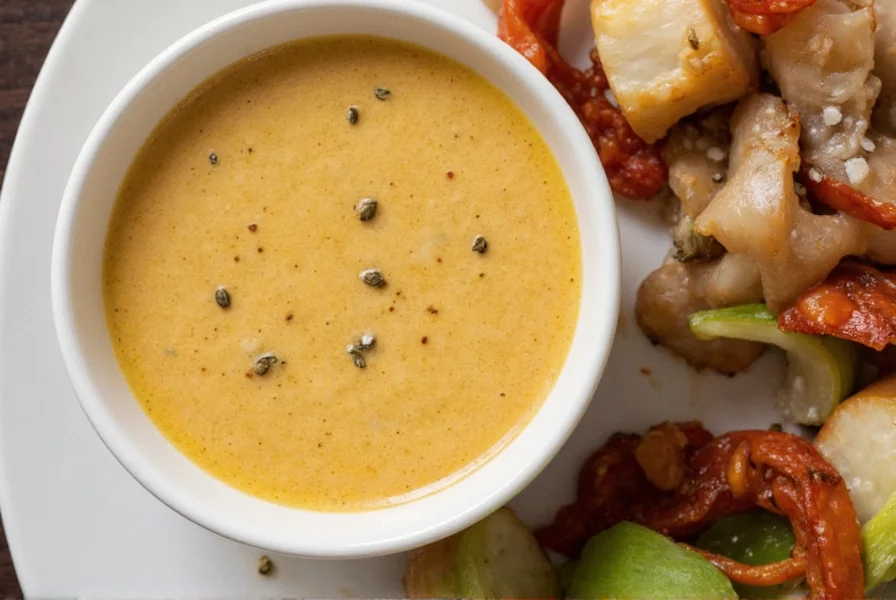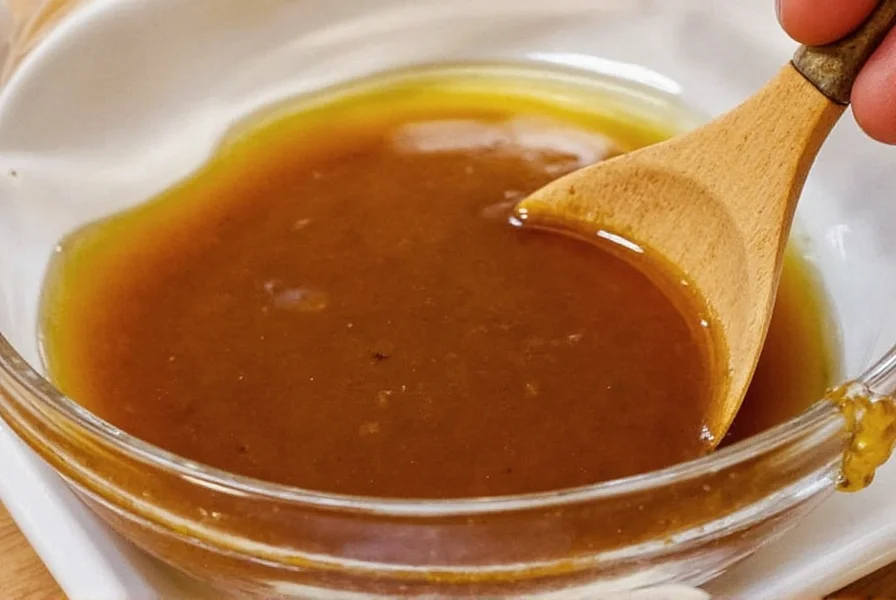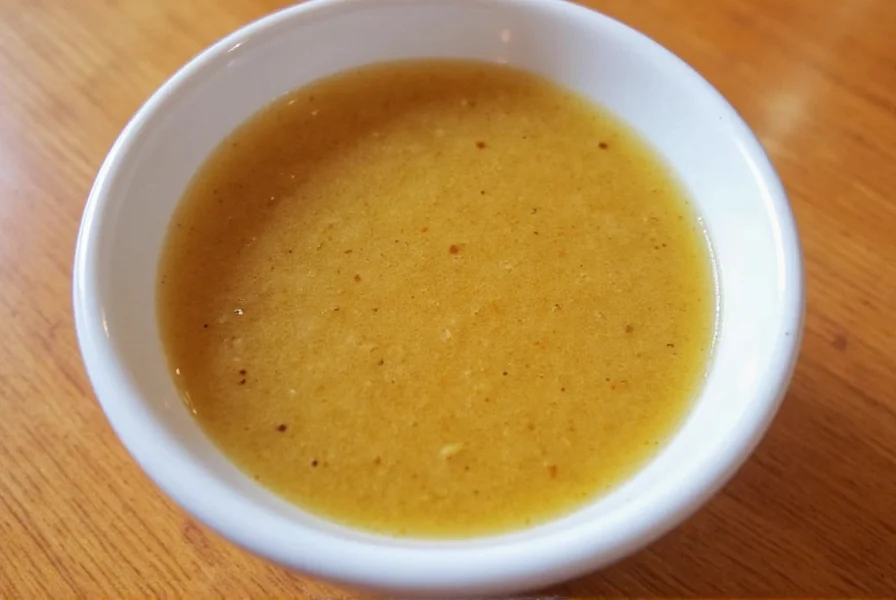If you've ever wondered what is ginger dressing at hibachi, you're not alone. This distinctive sauce plays a crucial role in the Japanese steakhouse dining experience, enhancing flavors without overwhelming the natural taste of grilled proteins and vegetables. Understanding its composition helps recreate the authentic hibachi experience at home or make informed choices when dining out.
What Exactly Is Hibachi Ginger Dressing?
Hibachi ginger dressing—sometimes called Japanese ginger sauce—is a staple at teppanyaki-style restaurants where chefs cook food on a flat iron griddle. Despite the "hibachi" name (which technically refers to a different Japanese cooking method), this dressing has become synonymous with the Americanized Japanese steakhouse experience.
The dressing's signature characteristic is its prominent fresh ginger flavor, which provides both heat and aromatic complexity. Professional hibachi chefs typically prepare large batches daily, keeping it readily available during the interactive cooking performance.

Core Ingredients of Authentic Hibachi Ginger Dressing
While recipes vary by restaurant, most authentic hibachi ginger dressing ingredients include:
| Primary Ingredients | Secondary Enhancements | Optional Additions |
|---|---|---|
| Fresh grated ginger | Rice vinegar | Honey or sugar |
| Soy sauce | Sesame oil | Green onions |
| Garlic (minced) | Rice wine | Red pepper flakes |
| Vegetable oil | Lime or lemon juice | Sesame seeds |
The precise balance determines whether the dressing leans more savory, sweet, or tangy. High-end hibachi establishments typically use fresh ingredients rather than powdered substitutes, which creates a more complex flavor profile with subtle heat from the ginger's natural compounds.
Flavor Profile and Culinary Characteristics
Authentic ginger dressing at japanese steakhouse venues delivers a multi-dimensional taste experience:
- Aromatic intensity from freshly grated ginger (not powder)
- Umami foundation from quality soy sauce
- Bright acidity from rice vinegar balancing the richness of grilled foods
- Subtle sweetness that enhances without dominating
- Noticeable but not overwhelming heat from ginger's zing
When properly made, the dressing should coat proteins lightly without making them soggy. The ginger flavor should be present throughout the eating experience, not just in the initial taste.
How Chefs Use Ginger Dressing During Hibachi Service
Understanding how to use ginger dressing at hibachi reveals why it's integral to the dining experience:
- Marinating - Chefs often lightly coat proteins before grilling to enhance flavor
- Cooking medium - Added to the grill during cooking to create flavorful steam
- Finishing sauce - Drizzled over completed dishes for fresh flavor impact
- Dipping sauce - Served on the side for customers to customize flavor intensity
- Vegetable enhancer - Tossed with grilled vegetables to prevent drying
During the cooking performance, you'll notice chefs spraying or pouring the dressing at strategic moments to create dramatic steam effects while simultaneously flavoring the food. This timing is crucial—adding it too early can cause burning, while adding it too late misses flavor infusion opportunities.
Homemade Hibachi Ginger Dressing Recipe
Recreating authentic homemade hibachi ginger dressing requires attention to ingredient quality and proportions. This restaurant-style recipe yields approximately 1 cup:
Ingredients:
- ½ cup rice vinegar
- ⅓ cup soy sauce (low sodium preferred)
- 3 tablespoons vegetable oil
- 2 tablespoons sesame oil
- 3 tablespoons fresh ginger, finely grated
- 2 tablespoons fresh garlic, minced
- 2 tablespoons sugar or honey
- 1 tablespoon fresh lime juice
- 1 teaspoon red pepper flakes (optional)
Instructions:
- Whisk all ingredients together in a bowl until sugar fully dissolves
- Let mixture rest for at least 30 minutes to allow flavors to meld
- Strain through fine mesh sieve for smoothest texture (optional)
- Store in airtight container in refrigerator for up to 2 weeks

Pro tip: For the most authentic hibachi ginger dressing recipe, use a microplane to grate fresh ginger directly into the mixture. The fine particles distribute flavor more evenly than coarsely chopped ginger.
Ginger Dressing vs. Other Hibachi Sauces
Many diners confuse different sauces served at hibachi restaurants. Understanding these distinctions enhances your dining experience:
- Ginger dressing - Clear, tangy, ginger-forward, used as both marinade and finishing sauce
- Yum yum sauce - Creamy, pinkish-orange, mayonnaise-based with paprika, primarily a dipping sauce
- Teriyaki sauce - Thicker, sweeter, soy-based glaze with pronounced caramel notes
- Spicy mayo - Creamy with noticeable heat, often used with seafood
The difference between hibachi ginger dressing and yum yum sauce is particularly important—ginger dressing provides bright acidity while yum yum sauce offers creamy richness. Many restaurants serve both simultaneously to provide contrasting flavor experiences.
How to Best Enjoy Ginger Dressing When Dining Out
When ordering ginger dressing at teppanyaki restaurant, consider these tips for optimal enjoyment:
- Ask if they make it fresh daily (indicates quality)
- Request it on the side to control application
- Try it with different proteins to compare flavor interactions
- Use it sparingly at first—you can always add more
- Pair with white meats (chicken, shrimp) for delicate flavor enhancement
Some high-end establishments offer house-made variations with premium ingredients like aged soy sauce or specialty vinegars. Don't hesitate to ask your chef about their specific preparation method.
Troubleshooting Common Ginger Dressing Issues
If your homemade hibachi style ginger dressing isn't turning out right, these fixes might help:
- Too salty - Add more vinegar or a touch of honey to balance
- Not enough ginger flavor - Increase fresh ginger quantity or let mixture steep longer
- Too thick - Add small amounts of water or additional vinegar
- Flavor too flat - Add citrus juice for brightness or red pepper for complexity
- Separating - Whisk vigorously or add small amount of cornstarch slurry
Remember that flavors continue developing after mixing, so taste again after 24 hours before making significant adjustments to your homemade ginger dressing recipe.
Frequently Asked Questions
What's the difference between hibachi ginger dressing and regular ginger dressing?
Hibachi ginger dressing is specifically formulated for teppanyaki-style cooking with a balance optimized for grilled foods. It typically contains rice vinegar instead of citrus juices found in salad ginger dressings, has a thinner consistency for spraying during cooking, and includes additional umami elements like soy sauce that complement grilled proteins. Regular ginger dressings for salads often contain more oil and citrus with less soy sauce.
Can I use store-bought ginger dressing for hibachi-style cooking at home?
While possible, most store-bought ginger dressings aren't ideal for authentic hibachi-style cooking. They're typically formulated as salad dressings with higher oil content that can cause flare-ups on high-heat cooking surfaces. For best results, use a recipe specifically designed for hibachi applications with proper viscosity and heat-resistant ingredients.
Why does restaurant ginger dressing taste different from my homemade version?
Professional hibachi restaurants typically use commercial-grade ingredients and precise ratios developed through extensive testing. Key differences often include: fresh daily preparation, specific soy sauce varieties, professional-grade rice vinegar, and the incorporation of cooking vapors from the griddle into the dressing during service. The high-heat cooking environment also caramelizes the dressing components in ways home stovetops cannot replicate.
Is hibachi ginger dressing gluten-free?
Traditional hibachi ginger dressing contains soy sauce, which typically includes wheat. However, you can make a gluten-free version by substituting tamari or certified gluten-free soy sauce. Always check with the restaurant about their specific ingredients if you have gluten sensitivity, as some establishments use regular soy sauce which contains wheat.











 浙公网安备
33010002000092号
浙公网安备
33010002000092号 浙B2-20120091-4
浙B2-20120091-4